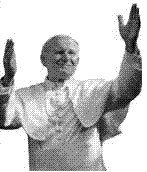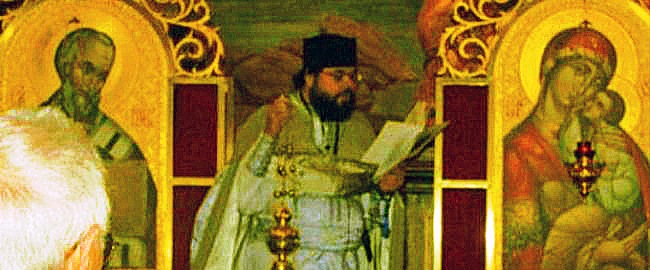“Conversion is required of the Latin Church that she may respect and
fully appreciate the dignity of Eastern Christians, and accept
gratefully the spiritual treasures of which the Eastern Catholic
Churches are bearers, to the benefit of the entire Catholic communion.”
- Pope John Paul II, The Light of the East, Orientale Lumen, 2nd May
1995, Par. 21

Why did the Holy Father urge Catholics with such forcefulness TO change
THEIR WAYS? He replies, "to show concretely, far more than in the past,
how much the Church esteems and admires the Christian East and how
essential she considers its contribution to the full realization of the
Church's universality".
History tells us that things were not always so. During the 17th and
18th centuries Latin Catholic missionaries went to many countries in
the Middle East and beyond, inhabited by numerous Eastern Catholics.
Campaigns were mounted to convert these peoples to Latin Catholicism or
at the very least to Latinize the various Eastern Rites in which these
Eastern Catholics worshipped; the autonomy of many churches was
abrogated to Latin bishops; the faithful were often denied the
ministry of their own priests. It was frequently held at the highest
levels of the Roman Catholic Church that the Latin Rite was “superior”
to all other rites.
By 1891, when our St. John’s Ukrainian Catholic parish was founded,
things had changed only very slightly. This is why so many of our
parishioners were and still are not even aware that there are real and
concrete differences in theology, spirituality, liturgy and canon law
between the Latin Church and our own Church.
It was not until 1964, that the bishops of the Universal Catholic Church
gathered at the Second Vatican Council, from both East and West, met and
proclaimed a renewed and more balanced theology of the Church. The
Council taught that the Universal Catholic Church is "a communion of
Churches" [Dogmatic Constitution on the Church, Lumen Gentium, par. 23].
This was thrashed out with a clearer refinement in the Council's
document on the Catholic Eastern Churches as follows:
“The Church is made up of the faithful who are organically united in
the Holy Spirit by the same faith, the same sacraments and the same
governance. They combine into different groups, which are held together
by their hierarchy, and so form individual churches.” [Decree on Eastern
Catholic Churches, Orientalium Ecclesiarium, par. 2]
The cold reality is harsh. Many things continue to happen which do
harm to the Christian upbringing of Eastern Catholic children and
adolescents. Eastern Catholic Bishops frequently deal with complaints
about the many attempts to confirm the children of their churches who
have already been baptized and chrismated in infancy. Latin Catholic
clergy frequently refuse communion to young children who are entitled to
receive holy communion from the time of their reception of the mysteries
of initiation which includes first Eucharistic communion. The
lamentable ignorance of some Catholic school teachers is demonstrated by
the not infrequent claims that Catholic schools are designed and meant
for the education of Latin Catholics exclusively; all others must simply
accept the regular religious practices offered in a one size fits all
approach.
When children of Eastern Catholic descent go to Catholic schools, they
become educated in a Latin Catholic spirituality to the extent that they
tend to become Latin Catholics themselves and abandon their Eastern
Church of origin. This is obviously a highly undesirable state of
affairs from the point of view of all the Catholic Churches.
It is high time that the Catholic school system systematically
respected the rights of all those Eastern Catholics who choose to enroll
in Catholic Schools. Take for example the wearing of the prayer rope
(chotki) which is clearly a religious emblem; most schools treat this as
a piece of jewelry and thus forbid it. Eastern Catholic and Eastern
Orthodox youth respond to such intolerance with an attitude of keep your
head down, tell no one that you are different; they feel that they must
hide their identity and comply with the expectations of the school's
dominant religious practices.
In 1995, Pope John Paul II proposed to respond to this problem even more
strongly. He listed six approved means by which mutual understanding
and unity might be improved between the Latin and the Eastern Churches.
He reasoned that an improved knowledge of one another must be a good
thing. The six means follow:
- To know the liturgy of the Eastern Churches; To deepen knowledge of the spiritual traditions of the Fathers and Doctors of the Christian East;
- To follow the example of the Eastern Churches for the enculturation of the Gospel message;
- To combat tensions between Latins and Orientals and to encourage dialogue between Catholics and the Orthodox;
- To train in specialized institutions theologians, liturgists, historians and canonists for the Christian East, who in turn can spread knowledge of the Eastern Churches;
- To offer appropriate teaching on these subjects in seminaries
and theological faculties, especially to future priests.
The Pope of Rome then added the following remark, "These remain sound recommendations on which I intend to insist with particular force." [Orientale Lumen, par. 24] - Finally, the demands of ecumenism and international dialogue
with the East have assumed primary importance in the agenda of Pope
Benedict XVI. Not only ought we support this program of dialogue
but we need to be very clear about our identity as Eastern Catholic
Churches.
[The above was adapted for our St John’s church bulletin and most of it is copied from a much larger document, authored by Fr. Olexander Kenez and Fr Brian Kelty, entitled “Some Issues regarding the Education of Eastern Catholic children in Latin Catholic Schools”, endorsed on March 13, 2009, and sent by the Australian Eastern Catholic Bishops to the Australian Roman Catholic Bishops and Roman Catholic Teachers.]






